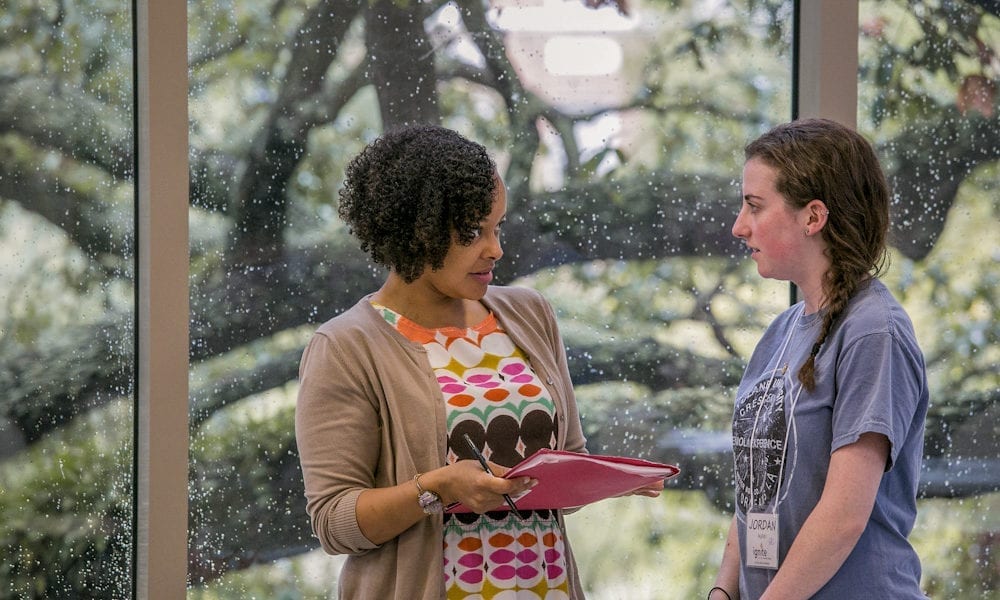
A 5-step process to design difficult and meaningful conversations
By Samantha Fleurinor, Taylor Center Senior Program Coordinator

Design thinking (DT) often elicits images of post it notes flying across the room, groups huddled over coarse prototypes made of cheap material, and enthusiastic millennials who are ready to take criticism with a smile. While these images are steeped in truth, DT is more than colorful post-it notes. DT has been used to innovate products like the MRI machine, improve customer interactions within healthcare systems, and redesign classrooms for better student engagement.
Fortunately, you don’t need a major project or wicked problem to use DT. Everyday interactions offer people opportunities to dig into this helpful process. Aside from designing I find the empathy, prototyping and testing aspects of design thinking most useful when I am trying to have difficult conversations or coaching students through an issue.
Here is a 5-step process that I use to design difficult and meaningful conversations.

Step 1: Recognize your positionality within the relationship.
Positionality is how your power which may present itself through racial identity, social position, gender, or age may affect the interaction. For me, positionality is most salient when there is a perceived or known difference between myself and the person I am speaking to. As a black woman working in academia, my race, gender, education level, age, and professional status (staff member), play either an individual role (woman talking to a man) or interlocking roles (black staff woman talking to a white male faculty member) in the dialogue.
Plus, power shifts. For me, approaching a student about an issue has a different power dynamic than approaching my supervisor. Conflict often emerges from differences that are beneath the surface and unknown. For example, you can’t tell who is exempt and non-exempt by looking at someone but these dynamics may rise in the face of conflict-related to work culture.
Power in any form whether known or unknown will shape the conversation so understanding the positionality of the folks entering the conversation creates an authentic experience with positive results.

Step 2: Design is about both the process and the outcome.
Once you have considered the power dynamics of the relationship, start considering your desired outcome for the conversation:
- Are you trying to change someone’s mind?
- Are you addressing a behavior or habit?
- Do you want to just clear the air?
Your aim is your guiding star for shaping the best results for your hard conversation. This also helps narrow the scope of the conversation.
One of the pitfalls of hard conversations is trying to cram all your grievances into one interaction. This can lead to unwarranted and unconstructive criticism, hurt feelings, and resentment. To avoid this, jot down a few goals for the conversation and focus on one. You should also establish your boundaries during this moment. If X doesn’t happen, then I will do Y.
For example, I was trying to have a hard conversation with a student employee about their performance. Unfortunately, they weren’t completing tasks, came into the office late, or didn’t show up at all. Before I entering the conversation, I determined that I would provide whatever resources needed to ensure her success but unless I saw improvement, we would have to find other arrangements. Outlining those expectations helped me navigate the conversation without falling into a habit of not sharing my needs or expectations.

Step 3: Empathy, humility, and human-centeredness are the key ingredients for designing any effective intervention.
Consider the person you are trying to have the discussion with. I personally prefer direct conversations that allow me to tackle the problem head on. Others may avoid conflict like the plague and need warming up before engaging.
Try to understand the other person’s communication style by recalling earlier conversations. How did they approach it? This can inform how and when you engage.

Step 4: Consider how you could sabotage this conversation.
This may sound counterintuitive but considering the ways you could completely destroy the relationship with this difficult conversation can help you transform a potentially awful experience into a great interaction.
Then ask a trusted friend, colleague, or peer to practice the conversation. Ask no more than two people. You don’t want to create drama by letting everyone know that you have beef with someone. It may be helpful to practice your conversation with someone who knows the other person and someone who isn’t affiliated. Have them role-play the other person and share their feelings. Incorporate suggestions and try again.

Step 5: Now that you’ve designed, prototyped, and tested your experience, you’re ready to have that hard conversation.
Take that deep breath, drink that herbal tea and approach the person you want to talk to.
Remember that if you’re willing to have this conversation, it is likely you want to preserve this relationship so consider goodwill and intent no matter how the conversation goes.